“A Swede who wrote a trilogy about collecting bugs, an Egyptian doctor who put pants on rats to study their s*x lives and a British researcher who lived like an animal have been named winners of the Ig Nobels, the annual spoof prizes for quirky scientific achievement. The winners were honored – or maybe dishonored – Thursday in a zany ceremony at Harvard University. The 26th annual event featured a paper airplane air raid and a tic-tac-toe contest with a brain surgeon, a rocket scientist and four real Nobel laureates. Winners receive $10 trillion cash prizes – in virtually worthless Zimbabwean money.
This year's Ig Nobels, sponsored by the science humor magazine Annals of Improbable Research , included research by Fredrik Sjoberg, who published three volumes about collecting hoverflies on the sparsely populated Swedish island where he lives. It sounds downright dull, but Sjoberg's books are a hit in his homeland, and the first volume's English translation, “The Fly Trap”, has earned rave reviews. “I had written books for 15 years (read by no one) when I finally understood it's a good thing to write about something you really know, no matter what that might be”, Sjoberg said in an email, describing the award as the pinnacle of his career. “The Ig Nobel Prize beats everything”, he said. “At last I hope to become a rock star. Leather pants, dark sunglasses, groupies. All that”.
Ahmed Shafik decided rats needed pants. He dressed his rodents in polyester, cotton, wool and polyester-cotton blend pants to determine the different textiles' effects on s*x drive. The professor at Cairo University in Egypt, who died in 2007, found that rats that wore polyester or polyester blend pants displayed less sexual activity, perhaps because of the electrostatic charges created by polyester. He suggested that the results could be applied to humans. The study did not explain how he measured a rat's waist and inseam.
Charles Foster, a fellow at the University of Oxford in the United Kingdom, won for literally living like an animal. He spent months mimicking a badger, an otter, a fox, a deer and a bird in an attempt to see the world through their eyes, then wrote a book, “Being a Beast”, about his experiences. He lived as a badger in a hole in a Welsh hillside; rummaged like a fox through trash cans in London's East End looking for scraps of chicken tikka masala and pepperoni pizza; and was tracked by bloodhounds through the Scottish countryside to learn what it's like to be a deer. It wasn't much fun. “I was hunted down quite quickly”, he said.
Andreas Sprenger was part of a team at the University of Luebeck in Germany that found that if you have an itch on one arm, you can relieve it by looking in a mirror and scratching the opposite arm. Sound silly? But imagine, Sprenger said via email, if you have a skin condition with an intolerable itch, you can scratch the other arm to relieve it without rubbing the affected arm raw.
Gordon Logan, a professor of psychology at Vanderbilt University, and colleagues from Canada and Europe won for their research on lying. Their study of more than 1,000 people who are ages 6 to 77 – “From junior to senior Pinocchio: A cross-sectional lifespan investigation of deception” – found that young adults are the best liars. How do the scientists know their subjects weren't lying to them? “We don't”, Logan said”. – Mark Pratt via The Associated Press
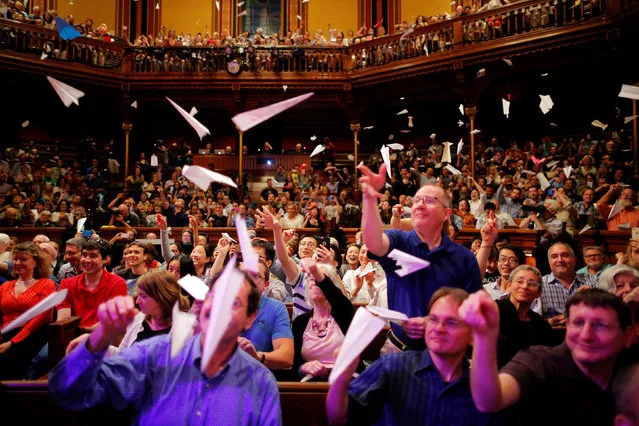
Audience members throw paper airplanes at the stage during the 26th First Annual Ig Nobel Prize ceremony at Harvard University in Cambridge, Massachusetts, U.S. September 22, 2016. (Photo by Brian Snyder/Reuters)
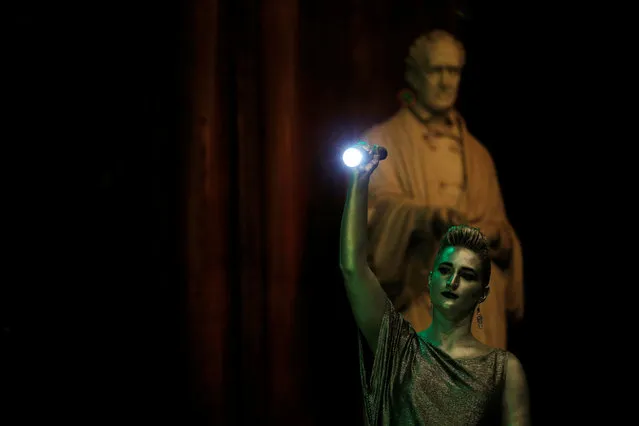
Human spotlight Katrina Rosenberg lights the stage during the 26th First Annual Ig Nobel Prize ceremony at Harvard University in Cambridge, Massachusetts, U.S. September 22, 2016. (Photo by Brian Snyder/Reuters)
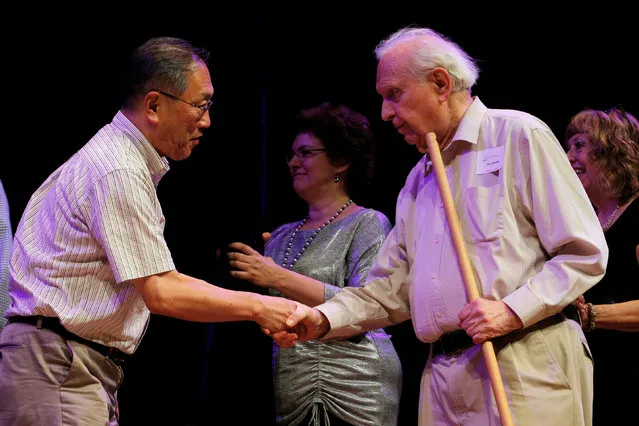
Nobel Laurette Roy Glauber (R) congratulates Atsugi Higashiyama of Japan for winning the 2016 Ig Nobel Prize in Perception for “investigating whether things look different when you bend over and view them between your legs” during the 26th First Annual Ig Nobel Prize ceremony at Harvard University in Cambridge, Massachusetts, U.S. September 22, 2016. (Photo by Brian Snyder/Reuters)
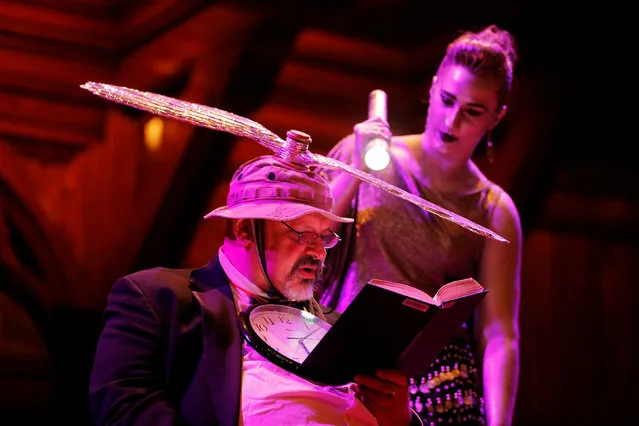
"Majordomo" Gary Dryfoos sits onstage before the 26th First Annual Ig Nobel Prize ceremony at Harvard University in Cambridge, Massachusetts, U.S. September 22, 2016. (Photo by Brian Snyder/Reuters)
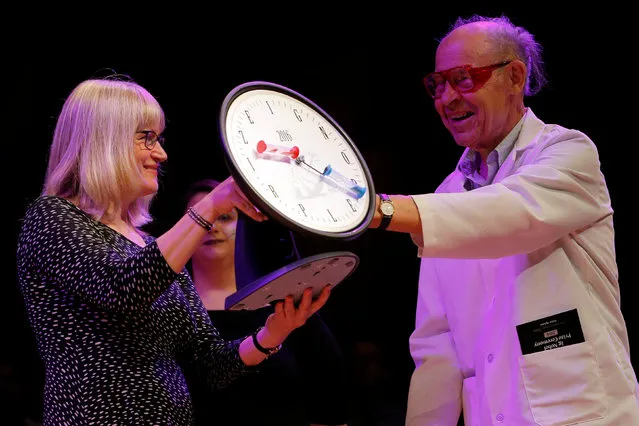
Nobel Laurette Dudley Herschbach (R) presents the 2016 IgNobel Prize in Physics to Susanne Akesson of Sweden for work “discovering why white-haired horses are the most horsefly-proof horses, and for discovering why dragonflies are fatally attracted to black tombstones” during the 26th First Annual Ig Nobel Prize ceremony at Harvard University in Cambridge, Massachusetts, U.S. September 22, 2016. (Photo by Brian Snyder/Reuters)
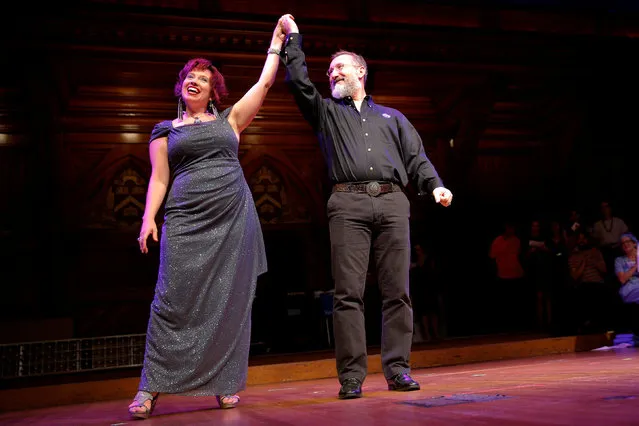
NASA scientists Lisa Danielson (L) and Will Stepanov are celebrated onstage for their wedding anniversary during the 26th First Annual Ig Nobel Prize ceremony at Harvard University in Cambridge, Massachusetts, U.S. September 22, 2016, fifteen years after they were married during an IgNobel prize ceremony. (Photo by Brian Snyder/Reuters)
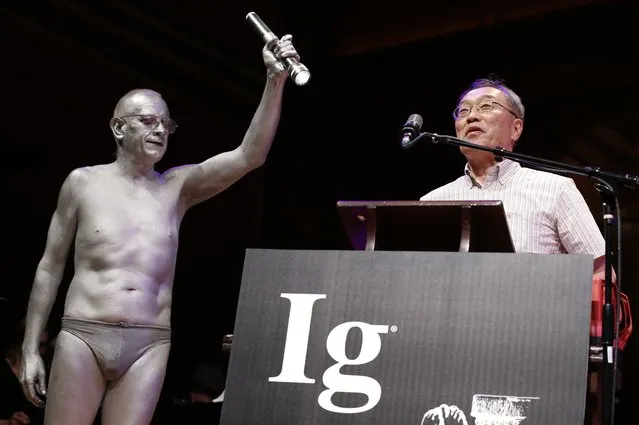
Atsuki Higashiyama, from Ritsumeikan University in Japan, speaks after receiving the Ig Nobel Perception Prize during ceremonies at Harvard University in Cambridge, Mass., Thursday, September 22, 2016. Higashiyama was awarded the prize for investigating whether things look different when you bend over and view them between your legs. (Photo by Michael Dwyer/AP Photo)
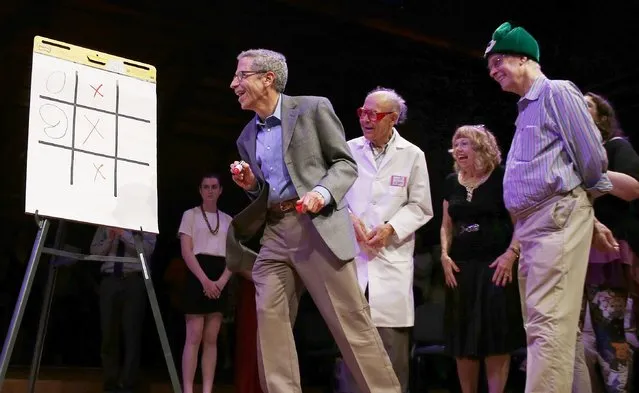
Nobel laureates Rich Roberts (physiology or medicine, 1993), right, Dudley Herschbach (chemistry, 1986) third from right, and Eric Maskin (economics, 2007), second from left, compete in a game of “tic-toc-toe” with a brain surgeon during the Ig Nobel award ceremonies at Harvard University in Cambridge, Mass., Thursday, September 22, 2016. (Photo by Michael Dwyer/AP Photo)
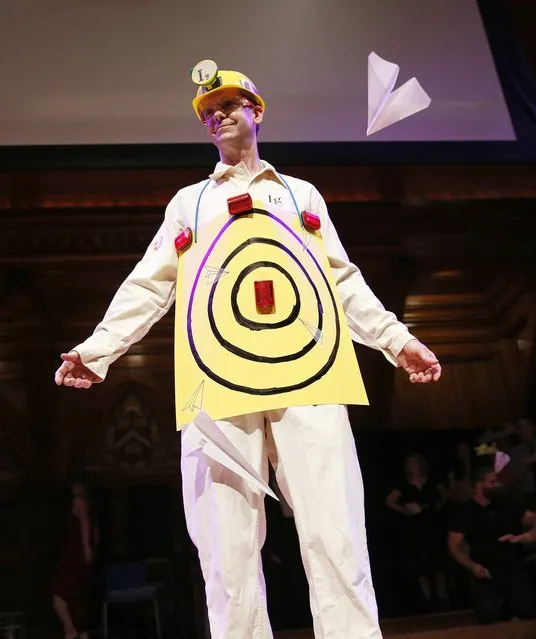
Human Aeorodrome Eric Workman acts as a target for paper airplanes during the Ig Nobel award ceremonies at Harvard University in Cambridge, Mass., Thursday, September 22, 2016. (Photo by Michael Dwyer/AP Photo)
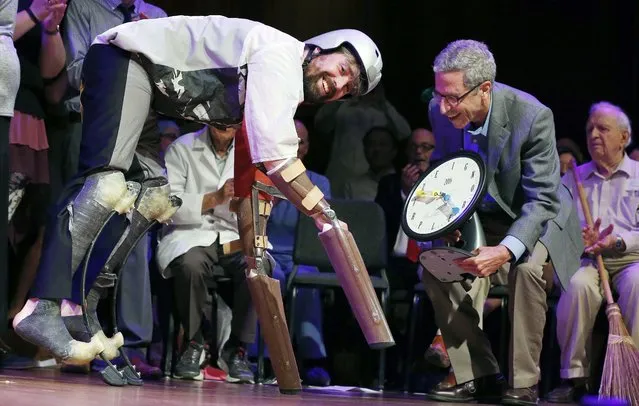
Thomas Thwaites, left, accepts the Ig Nobel prize in biology from Nobel laureate Eric Maskin (economics, 2007) during ceremonies at Harvard University in Cambridge, Mass., Thursday, September 22, 2016. Thwaites, of the United Kingdom, won for creating prosthetic extensions of his limbs that allowed him to move like and to roam in the company of goats. (Photo by Michael Dwyer/AP Photo)
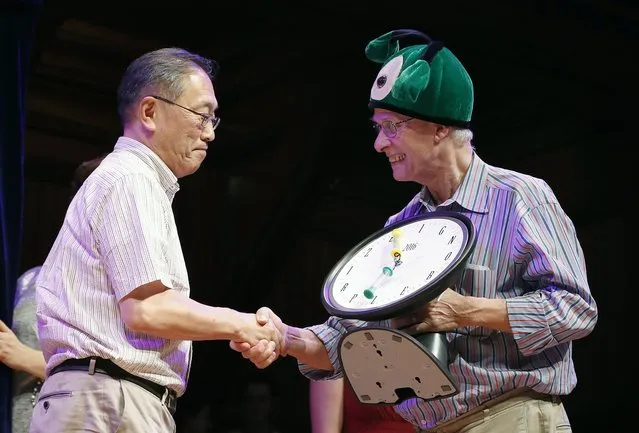
Atsuki Higashiyama, left, from Ritsumeikan University in Japan, accepts the Ig Nobel Perception Prize from Nobel laureate Rich Roberts (physiology or medicine, 1993) during ceremonies at Harvard University in Cambridge, Mass., Thursday, September 22, 2016. Higashiyama was awarded the prize for investigating whether things look different when you bend over and view them between your legs. (Photo by Michael Dwyer/AP Photo)
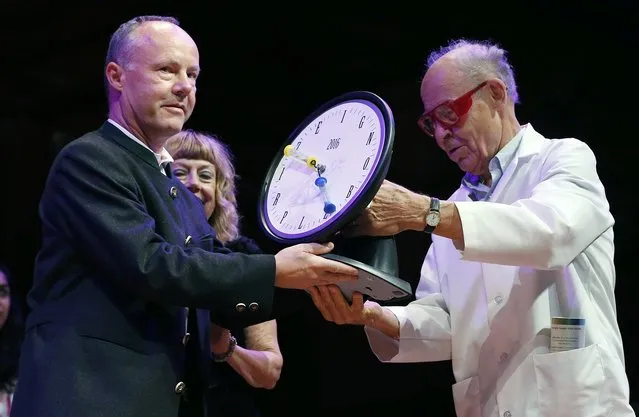
Fredrik Sjoberg, left, of Sweden, accepts the Ig Nobel award in literature from Nobel laureate Dudley Herschbach (chemistry, 1986) during ceremonies at Harvard University in Cambridge, Mass., Thursday, September 22, 2016. Sjoberg's research led him to publish three volumes about collecting hoverflies on the sparsely populated Swedish island where he lives. His books are a hit in his homeland and the first volume's English translation, “The Fly Trap”, has earned rave reviews. (Photo by Michael Dwyer/AP Photo)
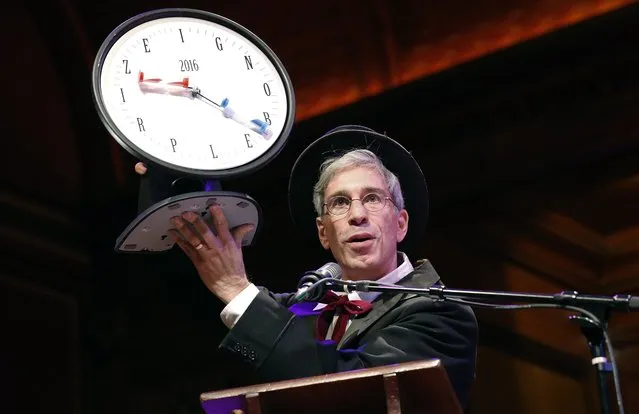
Master of Ceremonies Marc Abrahams holds up the 2016 Ig Nobel award during ceremonies at Harvard University in Cambridge, Mass., Thursday, September 22, 2016. (Photo by Michael Dwyer/AP Photo)
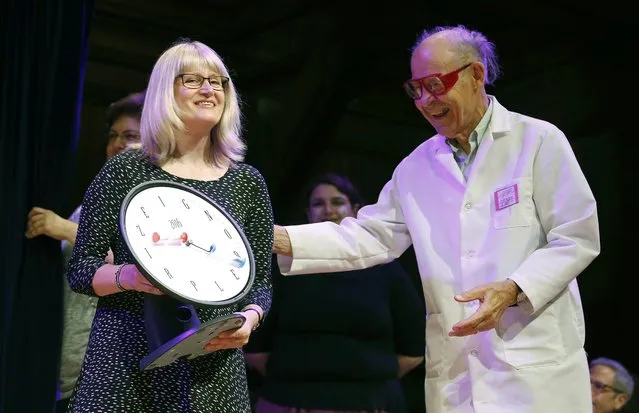
Susanne Akesson, left, accepts the Ig Nobel prize in physics from Nobel laureate Dudley Herschbach (chemistry, 1986) during ceremonies at Harvard University in Cambridge, Mass., Thursday, September 22, 2016. Akesson, from Lund University in Sweden, was part of a team that discovered why white-haired horses are the most horsefly-proof horses and for discovering why dragon flies are fatally attracted to black tombstones. (Photo by Michael Dwyer/AP Photo)
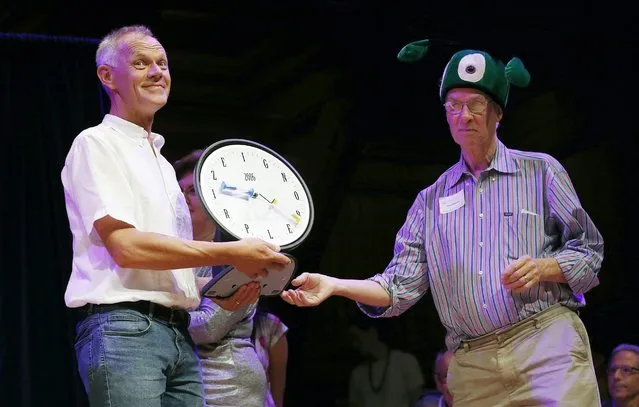
Andreas Sprenger, left, accepts the Ig Nobel award in medicine from Nobel laureate Rich Roberts (physiology or medicine, 1993) during ceremonies at Harvard University in Cambridge, Mass., Thursday, September 22, 2016. Sprenger was part of a team at the University of Luebeck in Germany that found that if you have an itch on one arm, you can relieve it by looking in a mirror and scratching the opposite arm. (Photo by Michael Dwyer/AP Photo)
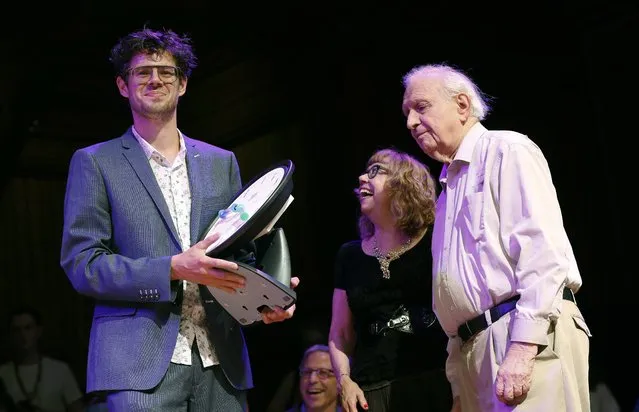
Bruno Verschuere, from the University of Amsterdam in the Netherlands, accepts the Ig Nobel award in psychology from Nobel laureate Roy Glauber (physics, 2005), right, during ceremonies at Harvard University in Cambridge, Mass., Thursday, September 22, 2016. Verschuere was part of a team that won for their research on lying. Their study of more than 1,000 people between the ages of 6 and 77 – “From junior to senior Pinocchio: A cross-sectional lifespan investigation of deception” – found that young adults are the best liars. (Photo by Michael Dwyer/AP Photo)
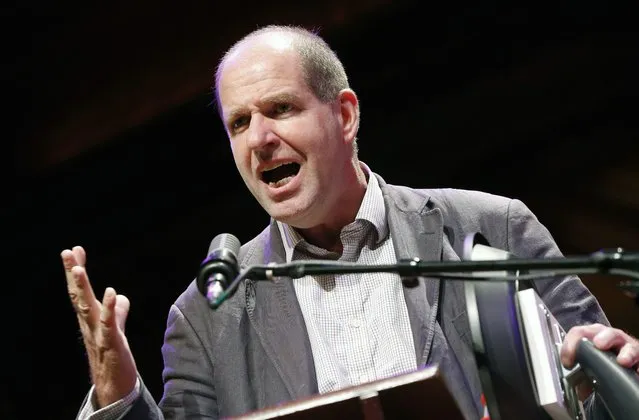
Charles Foster speaks after receiving the Ig Nobel prize in biology during ceremonies at Harvard University in Cambridge, Mass., Thursday, September 22, 2016. Foster, a fellow at the University of Oxford in the United Kingdom, won for literally living like an animal. He spent months mimicking a badger, otter, fox, deer and bird in an attempt to see the world through their eyes, then wrote a book about his experiences called “Being a Beast”. (Photo by Michael Dwyer/AP Photo)
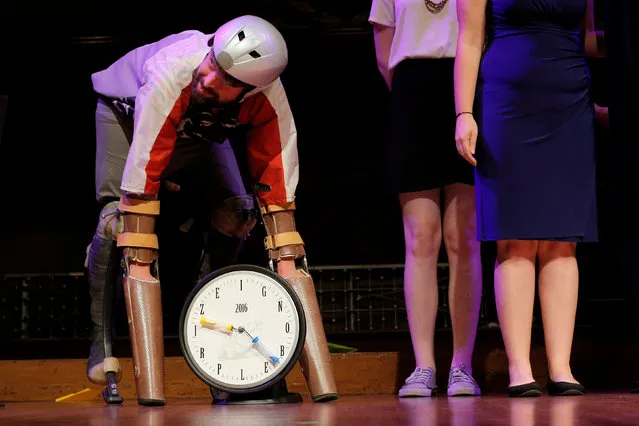
Thomas Thwaites of the United Kingdom accepts the 2016 Ig Nobel Prize in Biology for “creating prosthetic extensions of his limbs that allowed him to move in the manner of, and spend time roaming the hills in the company of, goats” during the 26th First Annual Ig Nobel Prize ceremony at Harvard University in Cambridge, Massachusetts, U.S. September 22, 2016. (Photo by Brian Snyder/Reuters)
This year's Ig Nobels, sponsored by the science humor magazine Annals of Improbable Research , included research by Fredrik Sjoberg, who published three volumes about collecting hoverflies on the sparsely populated Swedish island where he lives. It sounds downright dull, but Sjoberg's books are a hit in his homeland, and the first volume's English translation, “The Fly Trap”, has earned rave reviews. “I had written books for 15 years (read by no one) when I finally understood it's a good thing to write about something you really know, no matter what that might be”, Sjoberg said in an email, describing the award as the pinnacle of his career. “The Ig Nobel Prize beats everything”, he said. “At last I hope to become a rock star. Leather pants, dark sunglasses, groupies. All that”.
Ahmed Shafik decided rats needed pants. He dressed his rodents in polyester, cotton, wool and polyester-cotton blend pants to determine the different textiles' effects on s*x drive. The professor at Cairo University in Egypt, who died in 2007, found that rats that wore polyester or polyester blend pants displayed less sexual activity, perhaps because of the electrostatic charges created by polyester. He suggested that the results could be applied to humans. The study did not explain how he measured a rat's waist and inseam.
Charles Foster, a fellow at the University of Oxford in the United Kingdom, won for literally living like an animal. He spent months mimicking a badger, an otter, a fox, a deer and a bird in an attempt to see the world through their eyes, then wrote a book, “Being a Beast”, about his experiences. He lived as a badger in a hole in a Welsh hillside; rummaged like a fox through trash cans in London's East End looking for scraps of chicken tikka masala and pepperoni pizza; and was tracked by bloodhounds through the Scottish countryside to learn what it's like to be a deer. It wasn't much fun. “I was hunted down quite quickly”, he said.
Andreas Sprenger was part of a team at the University of Luebeck in Germany that found that if you have an itch on one arm, you can relieve it by looking in a mirror and scratching the opposite arm. Sound silly? But imagine, Sprenger said via email, if you have a skin condition with an intolerable itch, you can scratch the other arm to relieve it without rubbing the affected arm raw.
Gordon Logan, a professor of psychology at Vanderbilt University, and colleagues from Canada and Europe won for their research on lying. Their study of more than 1,000 people who are ages 6 to 77 – “From junior to senior Pinocchio: A cross-sectional lifespan investigation of deception” – found that young adults are the best liars. How do the scientists know their subjects weren't lying to them? “We don't”, Logan said”. – Mark Pratt via The Associated Press

Audience members throw paper airplanes at the stage during the 26th First Annual Ig Nobel Prize ceremony at Harvard University in Cambridge, Massachusetts, U.S. September 22, 2016. (Photo by Brian Snyder/Reuters)

Human spotlight Katrina Rosenberg lights the stage during the 26th First Annual Ig Nobel Prize ceremony at Harvard University in Cambridge, Massachusetts, U.S. September 22, 2016. (Photo by Brian Snyder/Reuters)

Nobel Laurette Roy Glauber (R) congratulates Atsugi Higashiyama of Japan for winning the 2016 Ig Nobel Prize in Perception for “investigating whether things look different when you bend over and view them between your legs” during the 26th First Annual Ig Nobel Prize ceremony at Harvard University in Cambridge, Massachusetts, U.S. September 22, 2016. (Photo by Brian Snyder/Reuters)

"Majordomo" Gary Dryfoos sits onstage before the 26th First Annual Ig Nobel Prize ceremony at Harvard University in Cambridge, Massachusetts, U.S. September 22, 2016. (Photo by Brian Snyder/Reuters)

Nobel Laurette Dudley Herschbach (R) presents the 2016 IgNobel Prize in Physics to Susanne Akesson of Sweden for work “discovering why white-haired horses are the most horsefly-proof horses, and for discovering why dragonflies are fatally attracted to black tombstones” during the 26th First Annual Ig Nobel Prize ceremony at Harvard University in Cambridge, Massachusetts, U.S. September 22, 2016. (Photo by Brian Snyder/Reuters)

NASA scientists Lisa Danielson (L) and Will Stepanov are celebrated onstage for their wedding anniversary during the 26th First Annual Ig Nobel Prize ceremony at Harvard University in Cambridge, Massachusetts, U.S. September 22, 2016, fifteen years after they were married during an IgNobel prize ceremony. (Photo by Brian Snyder/Reuters)

Atsuki Higashiyama, from Ritsumeikan University in Japan, speaks after receiving the Ig Nobel Perception Prize during ceremonies at Harvard University in Cambridge, Mass., Thursday, September 22, 2016. Higashiyama was awarded the prize for investigating whether things look different when you bend over and view them between your legs. (Photo by Michael Dwyer/AP Photo)

Nobel laureates Rich Roberts (physiology or medicine, 1993), right, Dudley Herschbach (chemistry, 1986) third from right, and Eric Maskin (economics, 2007), second from left, compete in a game of “tic-toc-toe” with a brain surgeon during the Ig Nobel award ceremonies at Harvard University in Cambridge, Mass., Thursday, September 22, 2016. (Photo by Michael Dwyer/AP Photo)

Human Aeorodrome Eric Workman acts as a target for paper airplanes during the Ig Nobel award ceremonies at Harvard University in Cambridge, Mass., Thursday, September 22, 2016. (Photo by Michael Dwyer/AP Photo)

Thomas Thwaites, left, accepts the Ig Nobel prize in biology from Nobel laureate Eric Maskin (economics, 2007) during ceremonies at Harvard University in Cambridge, Mass., Thursday, September 22, 2016. Thwaites, of the United Kingdom, won for creating prosthetic extensions of his limbs that allowed him to move like and to roam in the company of goats. (Photo by Michael Dwyer/AP Photo)

Atsuki Higashiyama, left, from Ritsumeikan University in Japan, accepts the Ig Nobel Perception Prize from Nobel laureate Rich Roberts (physiology or medicine, 1993) during ceremonies at Harvard University in Cambridge, Mass., Thursday, September 22, 2016. Higashiyama was awarded the prize for investigating whether things look different when you bend over and view them between your legs. (Photo by Michael Dwyer/AP Photo)

Fredrik Sjoberg, left, of Sweden, accepts the Ig Nobel award in literature from Nobel laureate Dudley Herschbach (chemistry, 1986) during ceremonies at Harvard University in Cambridge, Mass., Thursday, September 22, 2016. Sjoberg's research led him to publish three volumes about collecting hoverflies on the sparsely populated Swedish island where he lives. His books are a hit in his homeland and the first volume's English translation, “The Fly Trap”, has earned rave reviews. (Photo by Michael Dwyer/AP Photo)

Master of Ceremonies Marc Abrahams holds up the 2016 Ig Nobel award during ceremonies at Harvard University in Cambridge, Mass., Thursday, September 22, 2016. (Photo by Michael Dwyer/AP Photo)

Susanne Akesson, left, accepts the Ig Nobel prize in physics from Nobel laureate Dudley Herschbach (chemistry, 1986) during ceremonies at Harvard University in Cambridge, Mass., Thursday, September 22, 2016. Akesson, from Lund University in Sweden, was part of a team that discovered why white-haired horses are the most horsefly-proof horses and for discovering why dragon flies are fatally attracted to black tombstones. (Photo by Michael Dwyer/AP Photo)

Andreas Sprenger, left, accepts the Ig Nobel award in medicine from Nobel laureate Rich Roberts (physiology or medicine, 1993) during ceremonies at Harvard University in Cambridge, Mass., Thursday, September 22, 2016. Sprenger was part of a team at the University of Luebeck in Germany that found that if you have an itch on one arm, you can relieve it by looking in a mirror and scratching the opposite arm. (Photo by Michael Dwyer/AP Photo)

Bruno Verschuere, from the University of Amsterdam in the Netherlands, accepts the Ig Nobel award in psychology from Nobel laureate Roy Glauber (physics, 2005), right, during ceremonies at Harvard University in Cambridge, Mass., Thursday, September 22, 2016. Verschuere was part of a team that won for their research on lying. Their study of more than 1,000 people between the ages of 6 and 77 – “From junior to senior Pinocchio: A cross-sectional lifespan investigation of deception” – found that young adults are the best liars. (Photo by Michael Dwyer/AP Photo)

Charles Foster speaks after receiving the Ig Nobel prize in biology during ceremonies at Harvard University in Cambridge, Mass., Thursday, September 22, 2016. Foster, a fellow at the University of Oxford in the United Kingdom, won for literally living like an animal. He spent months mimicking a badger, otter, fox, deer and bird in an attempt to see the world through their eyes, then wrote a book about his experiences called “Being a Beast”. (Photo by Michael Dwyer/AP Photo)

Thomas Thwaites of the United Kingdom accepts the 2016 Ig Nobel Prize in Biology for “creating prosthetic extensions of his limbs that allowed him to move in the manner of, and spend time roaming the hills in the company of, goats” during the 26th First Annual Ig Nobel Prize ceremony at Harvard University in Cambridge, Massachusetts, U.S. September 22, 2016. (Photo by Brian Snyder/Reuters)
24 Sep 2016 10:46:00,
post received
0 comments
